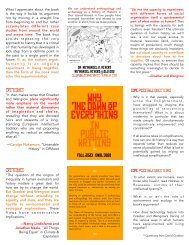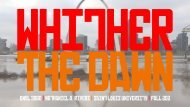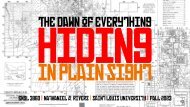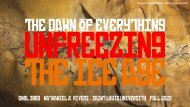ENGL 3860: Full Circle
Create successful ePaper yourself
Turn your PDF publications into a flip-book with our unique Google optimized e-Paper software.
The dawn of everything<br />
<strong>Full</strong><br />
<strong>Circle</strong><br />
<strong>ENGL</strong> <strong>3860</strong> | Nathaniel A. Rivers | saint Louis university | fall 2023
Portraying history as a story of material progress, that framework<br />
recast indigenous critics as innocent children of nature, whose<br />
views on freedom were a mere side effect of their uncultivated<br />
way of life and could not possibly offer a serious challenge to<br />
contemporary social thought (which came increasingly to mean just<br />
European thought).<br />
Graeber and Wengrow | The Dawn of Everything | 441
What evolution does not look like.
What evolution might look like.
Blinded by the ‘just so’ story of how human societies evolved, they<br />
can’t even see half of what’s now before their eyes. <br />
As a result, the same portrayers of world history who profess<br />
themselves believers in freedom, democracy and women’s rights<br />
continue to treat historical epochs of relative freedom, democracy<br />
and women’s rights as so many ‘dark ages’. Similarly, as we’ve<br />
seen, the concept of ‘civilization’ is still largely reserved for societies<br />
whose defining characteristics include high-handed autocrats,<br />
imperial conquests and the use of slave labour.<br />
Graeber and Wengrow | The Dawn of Everything | 442
The reason why these ways of thinking remain in place, no<br />
matter how many times people point out their<br />
incoherence, is precisely because we find it so difficult to<br />
imagine history that isn’t teleological—that is, to<br />
organize history in a way which does not imply that<br />
current arrangements were somehow inevitable.<br />
Graeber and Wengrow | The Dawn of Everything | 449
Cahokia’s population peaked at something in the order of 15,000<br />
people; then it abruptly dissolved. Whatever Cahokia represented in<br />
the eyes of those under its sway, it seems to have ended up being<br />
overwhelmingly and resoundingly rejected by the vast majority of<br />
its people. For centuries after its demise the site where the city once<br />
stood, and hundreds of miles of river valleys around it, lay entirely<br />
devoid of human habitation<br />
Graeber and Wengrow | The Dawn of Everything | 450
[W]hat we can say with some confidence is that the societies<br />
encountered by European invaders from the sixteenth<br />
century onwards were the product of centuries of political<br />
conflict and self-conscious debate. They were, in many cases,<br />
societies in which the ability to engage in self-conscious<br />
political debate was itself considered one of the highest human<br />
values.<br />
Graeber and Wengrow | The Dawn of Everything | 450
In Cahokia and its hinterland we can chart the<br />
rise of social hierarchies through the lens of<br />
chunkey, as the game became increasingly<br />
monopolized by an exclusive elite. One sign<br />
of this is how stone chunkey discs disappear<br />
from ordinary burials, just as beautifully crafted<br />
versions of them start to appear in the richest<br />
graves. Chunkey was becoming a spectator<br />
sport, and Cahokia the sponsor of a new<br />
Illinois State Museum<br />
regional, Mississippian elite.<br />
Graeber and Wengrow | The Dawn of Everything | 465
Whatever happened in<br />
Cahokia, it appears to<br />
have left extremely<br />
The “Vacant Quarter,” Circa 1450<br />
unpleasant memories.<br />
The Vacant Quarter<br />
implies a self-conscious<br />
rejection of everything<br />
the city of Cahokia stood<br />
for.<br />
Graeber and Wengrow | The Dawn of Everything | 468-69
What we would now call social movements often<br />
took the form of quite literal physical movements.<br />
Graeber and Wengrow | The Dawn of Everything | 469
[T]he Osage, who ascribed key roles to sacred<br />
knowledge in their political affairs, in no sense saw<br />
their social structure as something given from on high<br />
but rather as a series of legal and intellectual<br />
discoveries—even breakthroughs.<br />
Graeber and Wengrow | The Dawn of Everything | 480
What [t]his example demonstrates, we suggest, is that even within<br />
indigenous society, the political question was never definitively<br />
settled. Certainly, the overall direction, in the wake of Cahokia, was<br />
a broad movement away from overlords of any sort and towards<br />
constitutional structures carefully worked out to distribute power in<br />
such a way that they would never return. But the possibility that<br />
they might always lurked in the background. Other paradigms of<br />
governance existed, and ambitious men—or women—could, if<br />
occasion allowed, appeal to them.<br />
Graeber and Wengrow | The Dawn of Everything | 491
In other words, not only did indigenous North Americans<br />
manage almost entirely to sidestep the evolutionary trap that<br />
we assume must always lead, eventually, from agriculture to<br />
the rise of some all-powerful state or empire; but in doing so<br />
they developed political sensibilities that were ultimately to<br />
have a deep influence on Enlightenment thinkers and,<br />
through them, are still with us today.<br />
Graeber and Wengrow | The Dawn of Everything | 492
















